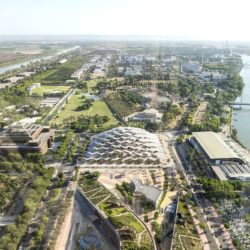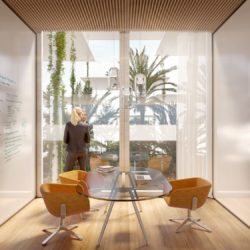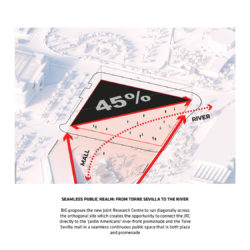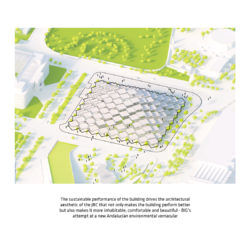
Located at the former Sevilla EXPO ´92 site, in Isla de la Cartuja, the new 9900 m2 building for the European Commission, ties into the City of Sevilla’s goal to become a global benchmark for sustainability by 2025 and the local vision of the eCitySevilla project to decarbonize and transition Isla de la Cartuja to 100% renewable energy sources. The JRC building will house 12 research units and supporting functions as well as public and private outdoor spaces. The international design competition kicked off in 2021 with 66 offices competing for the project, expected to break ground in 2024.
Inspired by the shaded plazas and streets of Seville, BIG proposes to cover the entire project site with a cloud of solar canopies sheltering the plaza, garden, and research building underneath, akin to the pergolas typical to Seville. The canopies consist of square lightweight PV sheets supported by a forest of slender columns. The roofscape cascades down from the center of the site to a human scale height at its periphery creating a variety of public spaces underneath it.
Underneath, the new Joint Research Centre building is positioned diagonally across the site to connect the JRC directly to the ‘Jardin Americano’ river-front and the Torre Sevilla market in a seamless continuous public space that is both plaza and promenade. Placing the building diagonally also creates a new public square on one side of the building and a private garden for the JRC community on the other.
The floorplates of the research centre step back as the building ascends, creating a series of terraces, shaded outdoor spaces for breakouts, relaxation, and informal meetings with views of the city.
Inside, the functions of the new JRC building are organized with public programs and amenities such as dining, a conference center and social spaces on the ground floor, while the offices and research units occupy the upper floors for privacy and security. The collaborative workplaces face the plaza, while the deep-focus workspaces face the garden. The proposed layout is designed to be entirely flexible and adaptable according to any future needs of the JRC.
Following the building geometry and modularity two diagonal voids connect all levels of the building, encouraging physical movement as well as social interaction and informal meetings. JRC staff and visitors will be more likely to take the stairs, increasing the chance of meetings and encounters between colleagues.
The passive design of the building through its shallow floorplate and constant shading under the pergola cloud enables natural cross ventilation and ideal light qualities, reducing the energy consumption typically used on artificial lightening, air conditioning and mechanical ventilation.
The design prioritizes locally sourced materials, such as limestone, wood, and ceramic tiling. The building structure is low-carbon concrete, reducing up to 30% of typical CO2 emissions, while the pergola cloud is made from recycled steel. Gardens, greenery from the region, and water elements in the outdoor environment seek to reduce/eliminate the heat island effect and create a comfortable microclimate.
_


















